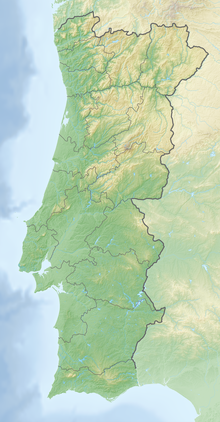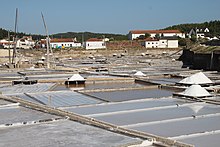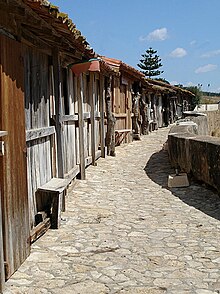Salinas da Fonte da Bica
Location of the Salinas da Fonte da Bica in Portugal. |
The Salinas da Fonte de Bica salt works , also known as Marinhas de Sal de Rio Maior , have been in operation since the 12th century and are one of the few Portuguese salt works that extract salt from a brine spring and not from seawater .
location
The saline is located about 3 km north of Rio Maior in the municipality of the same name ( Portuguese Freguesia ) and the district of the same name ( Portuguese concelho ) Rio Maior about 25 km northwest of the district capital Santarém .
It is located within the southwestern foothills of the Serras de Aires e Candeeiros between two ranges of hills about 30 km from the Atlantic . Geologically, the region is part of the Estremenho - massive limestone ( Portuguese Maciço Calcário Estremenho ).
history
According to legend, the place was discovered by a young girl who drank from the spring while tending a herd of cattle. After she told her parents about the unpleasant taste of the water, they and the other residents of the village went up and deepened the spring into a well and began to extract salt.
The first written message dates from 1177. The document relates to the sale of some salt basins by Pero D'Aragão (Baragão) and his wife Sancha Soares to the Knights Templar . Since the purchase falls in the period immediately after the Reconquista of this region, z. T. suspects that the brine spring was already used in Arab or even Roman times.
The great importance of the salt works is proven by a document from the 15th century, in which King Alfonso V (Portugal) ( Portuguese D. Alfonso V ) is listed as the owner of five of the pools. It has not yet been clarified whether the crown acquired these basins or whether they remained in the possession of the royal family in the course of the transfer of ownership from the Knights Templar to the Order of Christ .
In the 17th century - during the reign of John IV (Portugal) ( Portuguese João IV ) - the sale of salt basins from royal property to the Conde de Vimioso is documented. The theory that the saltworks remained completely in the possession of the royal family since the transfer of ownership from the Templar order to the crown in 1312 and was only sold by members of the Braganza family , cannot be verified due to the insufficient sources.
In 1979, the owners of the salt basins merged to form the Agricultural Cooperative of Salt Producers of Rio Maior ( Portuguese Cooperativa Agrícola dos Produtores de Sal de Rio Maior ) to support themselves in the commercial extraction and marketing.
In 1986 the water storage system was renewed and since then the extracted bottom has been distributed to the individual brine basins via modern PVC pipes.
In 1997 the saltworks was registered and protected as Imóvel de Interest Público . Since then, salt production has been continued in compliance with monument protection regulations.
The salt pans and the associated village have now developed into a tourist attraction, where the salt products are marketed directly on site.
Saltworks
The protected area of the salt works includes the actual brine well, the brine basin, which extends over an area of around 22,000 m², and the village of the salt workers.
Brine well
According to legend, the brine spring was deepened to a fountain immediately after its discovery. Today's well has a diameter of around 3.75 m and a depth of 9 meters. Until the 1980s, the brine was pumped manually with two swinging trees ( Portuguese picotas or cegonhas ), which in this form are traced back to Arab models. Today they are replaced by a motor pump.
The source is fed by one of the many underground watercourses that run through the limestone massif and a salt deposit formed in the early Jurassic ( Hettangian ), the salts dissolve and come to the surface here. With a salt content of around 220 grams per liter, the bottom is around seven times saltier than sea water.
Brine basin
Around the brine fountain, the approximately 470 rectangular and trapezoidal brine basins of the saline are distributed. 70 larger basins serve as a reservoir for the extracted bed before it is distributed to the roughly 400 smaller basins.
The basins have an average size of 7 × 5 m and are made of stone or, more recently, cement. In the middle of the basin there is a depression in which contaminants from the sole can be deposited during the evaporation process. The basins are complemented by a 1.5 m deep basin at the edge, which serves as a reservoir for the brine.
Originally, the basins were separated from each other by bridges bordered with wooden boards - called cockroaches ( Portuguese baratas ) - today bricks and stones are also used. In one corner of the pool you will often find a rectangular, wooden platform resting on four wooden posts. These small platforms are used to bleach and dry the salt that has been extracted from one or more adjacent basins before it is brought to the warehouses of the adjacent village.
Village
The village, located northwest and west of the salt basin, consists of simple residential and warehouse buildings with a rectangular floor plan. The buildings are entirely made of wood and furnished. Even the door locks are made of wood to prevent corrosion from the salt. Some of these typical wooden houses are now home to handicraft shops, cafes and restaurants, but the majority is used to market local salt products.
Salt extraction
The saltworks is not operated all year round, but only from May to September.
At the beginning of the year of operation, one of the 84 owners of the salt works is appointed who is responsible for the operation and maintenance of the plant. In earlier times, one of its tasks was to keep the two wells running continuously - a strenuous and, especially during the night, dangerous job. In return, the owner receives a certain share of the salt from the other salt mine owners in return.
After the basins have been filled with brine, harvesting can usually begin after seven days; if the weather conditions are very favorable in midsummer, the time can be shortened to 24 hours.
The salt workers ( Portuguese : marinheiros ) skim the salt from the basins with wooden rakes and let it dry and bleach on platforms, which are also wooden. These characteristic “salt pyramids” have been incorporated into the Rio Maior coat of arms today. After drying and bleaching, the salt is transported to the adjacent warehouses, broken, cleaned and processed for sale.
Individual evidence
- ↑ a b c d e f Salinas da Fonte da Bica . Direção – Geral do Património Cultural, accessed on February 23, 2019 (Portuguese).
- ↑ a b c d e f Cecília Matias: Salinas da Fonte da Bica. Direção – Geral do Património Cultural - Sistema de Informação para o Património Arquitectónico, 2008, accessed on February 23, 2019 (Portuguese).
- ↑ a b c d e f Georgette Goucha et al .: Marinhas de Sal - Rio Maior . Rio Maior, no year.
- ↑ Decree n.º 67/97 (= Ministério da Cultura [Ed.]: Diário da República, Series B . Band I , n.º 301). December 31, 1997, p. 6897 (Portuguese, dre.pt [PDF; accessed on March 16, 2019]).
literature
- Mário Vieira de Sá: Sal Comum . Lisbon 1951 (Portuguese).
- Further reading under Direção-Geral do Património Cultural - Sistema de Informação para o Património Arquitectónico sv Bibliografia.
Web links
- As Salinas. Retrieved March 15, 2019 (Portuguese, Official Website of the Rio Maior City Council).
Coordinates: 39 ° 21 ′ 50.2 " N , 8 ° 56 ′ 38.6" W.


